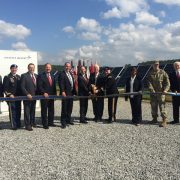SunPower Completes 10-Megawatt Solar and 1-Megawatt Storage Project at U.S. Army’s Redstone Arsenal
SAN JOSE, Calif., Feb. 26, 2018 /PRNewswire/ — SunPower Completes 10-Megawatt Solar project for the US Army
At a ribbon-cutting event recently, Redstone Arsenal and SunPower Corp. (NASDAQ: SPWR ) marked the commencement of operations for a 10-megawatt solar photovoltaic and 1-megawatt energy storage system at the U.S. Army post in Alabama. […]
Click here to view original web page at www.prnewswire.com
“Through innovative collaboration between the Army, Team Redstone, and industry partners, we’ve cost-effectively built a reliable, home-grown renewable energy project that is expected to deliver savings for decades, allowing us to invest more resources in protecting the nation and those we serve,” said Lt. Gen. Edward M. Daly, Senior Commander, Redstone Arsenal.
This project is a collaboration between the U.S. Army Office of Energy Initiatives, Redstone Arsenal, the U.S. Army Corps of Engineers, and SunPower, and features a SunPower® Oasis® Power Plant system. The fully integrated, modular solar power block is engineered and built for compatibility with a future micro-grid, and is paired with storage to reduce peak power-related demand charges for Redstone Arsenal.
“Demand for solar-and-storage technology continues to rise, delivering significant savings to customers with high electricity demand, like the U.S. military,” said Nam Nguyen, SunPower executive vice president. “We congratulate the Army and Redstone Arsenal for seeing the value in a resilient energy project from SunPower that will help lower operational costs and free up more funds to support their mission.”
The Army is purchasing 100 percent of the electricity generated by the project through a 27-year power purchase agreement (PPA) at rates competitive with traditional energy sources. Regions Bank is providing the capital required for the solar and storage project, eliminating the need for capital expenditure by the Army. Cornerstone Financial Advisors, LLC served as financial advisor to Region Bank on this transaction.
“Regions Bank supports the development of innovative clean energy generation by providing efficient financing solutions that take into consideration advances in technology, such as this project’s energy storage system,” said Frank Conley, Senior Vice President Solar Finance for Regions. “We are very pleased to team up with SunPower on the Redstone Arsenal solar facility and have a role in reducing the Army’s electricity costs while enhancing its clean energy utilization.”
SunPower is a trusted solar advisor to federal government agencies such as the Department of Energy and the Department of Defense, having deployed solar power systems at military facilities nationwide including more than 28 megawatts at Nellis Air Force Base in Nevada, 13.78 megawatts at Naval Air Weapons Station China Lake and 28 megawatts at Vandenberg Air Force Base in California, as well as 5.6 megawatts at the Air Force Academy in Colorado Springs.
For more information on how solar and storage solutions can benefit federal agencies, read SunPower’s blog post here or visit www.sunpower.com/government.
About SunPower
As one of the world’s most innovative and sustainable energy companies, SunPower (NASDAQ: SPWR) provides a diverse group of customers with complete solar solutions and services. Residential customers, businesses, governments, schools and utilities around the globe rely on SunPower’s more than 30 years of proven experience. From the first flip of the switch, SunPower delivers maximum value and superb performance throughout the long life of every solar system. Headquartered in Silicon Valley, SunPower has dedicated, customer-focused employees in Africa, Asia, Australia, Europe, and North and South America. For more information about how SunPower is changing the way our world is powered, visit www.sunpower.com.
SunPower’s Forward-Looking Statements
This press release contains “forward-looking statements” within the meaning of the Private Securities Litigation Reform Act of 1995, including, but not limited to, statements regarding projected energy output, expected cost savings, and project and financing plans. These forward-looking statements are based on our current assumptions, expectations, and beliefs and involve substantial risks and uncertainties that may cause results, performance, or achievement to materially differ from those expressed or implied by these forward-looking statements. Factors that could cause or contribute to such differences include, but are not limited to: regulatory changes and the availability of economic incentives promoting use of solar energy, challenges inherent in constructing and maintaining certain of our large projects, competition and market conditions in the solar and general energy industry, and fluctuations or declines in the performance of our solar panels and other products and solutions. A detailed discussion of these factors and other risks that affect our business is included in filings we make with the Securities and Exchange Commission (SEC) from time to time, including our most recent report on Form 10-K, particularly under the heading “Risk Factors.” A copy of this filing is available online from the SEC or on the SEC Filings section of our Investor Relations website at investors.sunpowercorp.com. All forward-looking statements in this press release are based on information currently available to us, and we assume no obligation to update these forward-looking statements in light of new information or future events.
©2018 SunPower Corporation. All Rights Reserved. SUNPOWER, the SUNPOWER logo, and OASIS are registered trademarks of SunPower Corporation in the U.S. and other countries as well.
SOURCE SunPower Corp.


